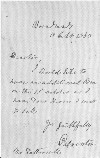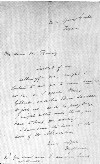| SOME GUESSES AS
TO HIS METHOD. |
With all the praise of Mr. Rarey, there came also the
attempt to imitate and to teach what he was teaching. One of these imitators was so bold
that Mr. Rarey authorized the Messrs. Tattersall to pay one thousand guineas to any man
who could satisfy them that he was able to teach the Rarey method of horse-taming unless
he had first learned it from Mr. Rarey. This offer brought some amusing claims. A. V. D.
Way, a German who was teaching modern languages in Dublin, wrote: "Having seen Mr. Rarey's letter, these lines are to state that that
gentleman's secret consists in looking sharply into the eyes of the horse to be tamed and
giving him some bread or other soft eatable, moistened with the tamer's own sweat. He
looks sharply into the eyes of the horse because the horse cannot bear the brilliancy of
the human eye, seeks to avoid the same and becomes by this manner afraid of the tamer, and
begins to become tamer and tamer. He gives him some bread or other things moistened with
sweat in order to make him do everything he likes, even to follow him like a dog, which
the horse does as soon as he has eaten something having the flavor of the tamer's sweat.
It is possible that Mr. Rarey employs but one of these two named, but that can be no
reason why the promised thousand guineas should not be paid to me. I knew this
secret these twenty-five years and having, therefore, not learned it from Mr. Rarey,
either directly or indirectly, I hope and trust I will bear from you by return post.
Pardon me this trouble, gentlemen, and believe me your humble ob'd't servant.
A. V. D. Way, from Germany.
"P. S. It strikes me that Mr. Rarey may say or think some words
in using the above, which words nobody might be able to guess, done in order to avoid the
payment of the 1000 guineas, but these words or other things are of no effect and can be
omitted.
A. V. D. Way."
Another letter, written from the Bristol Coffee House, ran:
"Believing that I have discovered Mr.
Rarey’s method of taming horses, I have taken the liberty of communicating with you
upon the subject, and of course, if I am correct, laying claim to the offered reward. If I
am right, it is neither more nor less than the use of magnifying spectacles, placed over
the eyes of the animal so as to terrify him with the apparent immensity of objects. I have
been led into this belief from the fact of my often having seen horses in the Crimea
brought to a sudden stand and exhibit great symptoms of terror at sight of a camel, and
the well known retentiveness of memory in the horse would assist in strengthening me in my
belief. Mr. Rarey's remark, as reported, about Cruiser being about to have been deprived
of sight also is an additional reason, because Mr. Rarey's audience would at once have
seen the inutility of depriving an animal of the only organ through which a wholesome and
yet human dread could be imparted. Awaiting the honor of your reply (prevent the
publication of this idea, if it should but slightly differ from Mr. Rarey's mode) I am,
gentlemen, your humble, ob’d’t servant,
N. Corringsby."
The only excuse for the prevalence of any mystery about Mr. Rarey's
method of training horses was his effort, in the earlier days of his career, to protect
himself financially. He gave lessons for a fee and sold a little book of instructions and
required every one who bought a book to pledge himself to keep the book private, not to
let anybody read it and, in handling horses, to prevent anybody from learning the secret
and not to instruct anybody in his art. Later, when his purposes had been served, he
publicly released everybody from the pledge and was glad to have the rule of kindness
everywhere proclaimed and practiced. |
|
|
In his earlier study of the nature of the horse, Mr. Rarey
observed that the animal acts upon knowledge received through his senses, seeing, hearing,
smelling and feeling; that he uses the nose as human beings do the hand to touch and feel
every object that is new to him and determine whether or not it is something to be feared.
In his boyhood, Mr. Rarey once turned a team of driving horses into a lot, in which there
were two or three stumps, on one of which he had thrown a buffalo robe. The first horse,
seeing the robe, was frightened. He ran to a point as far away from the robe as he could
get and, with head extended, walked around and around the stump, each time getting a
little nearer, until he could touch the robe with his nose. On the first contact, he
jumped back but, seeing that it did not move, he touched it again, finally seizing it with
his teeth and tossing it up and then jumping back again. After learning that the robe
could not harm him, the horse seized the robe and dragged it about the lot. That was the
boy's first lesson in the nature of the horse, but it was most valuable. It was the
foundation stone of his whole theory. So, in his lectures he declared that the only way to
tame or to train a horse is to work with, and not against, his intelligence, "for the
horse has intelligence and every good trait of character which, if cultivated, will make
him kind, docile and gentle." The horse must become acquainted with the person or
object before he can have confidence, and his only means to acquaintanceship are the
senses. So, in coming into the presence of a strange horse, Mr. Rarey approached slowly,
spoke gently, and stroked him lightly and kindly. Having established friendship with the
horse, he proceeded to prove to the animal that he was master. For this purpose he used
two straps and a surcingle. One strap he buckled around the fetlock, raising one front
foot; then he adjusted the surcingle around the horse's body, fastened the second strap,
with a running loop, to the other foreleg, passing the end through the surcingle and held
it in his hand. Thus, at the desired moment, he brought the horse to his knees and then to
a lying posture. There were times when this was done with great difficulty, but firmness,
courage and kindness always won sooner or later; and when the horse recognized that his
friend was also his master, there was no further trouble. The muscles of the animal's legs
relaxed, and the trainer's head was as safe at the horse's heels as it would have been on
a downy pillow. Of course, there was nothing in the invention of the straps or in the
recumbent posture, except that no other practical mode had been discovered, at once and
lastingly to subdue the force and stubbornness of the animal, without a violent contest
which must always irritate, frighten and perhaps ruin the most gentle subject. Replying to
the charge that he used drugs, magic and witchcraft, Mr. Rarey, in one of his lectures,
said: "The absurdity of this notion is apparent when we consider that, if the horse
could be tamed by any of these methods, we could apply them with the same efficacy upon
children---upon the human family. If any man tells you that he has a recipe for taming
horses, try it upon yourself and judge of its effect upon the horse. If you are not
knocked to the ground by the potency of the drug, then believe me it will have no more
effect upon the horse." Mr. Rarey did not claim to be able, in a single lesson, to
redeem a horse forever from vicious ways. What he did do was to indicate beyond all
possibility of doubt the true mode of treatment. He had to leave to others, by constant
and patient repetition, to lead the once unruly and evil-minded horse to that constant and
kindly service of which, as he believed, every animal is capable. |

